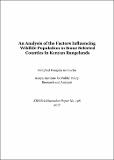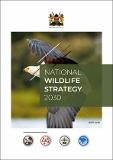Discussion Paper No. 198 of 2017 on An Analysis of the Factors Influencing Wildlife Population in Some Selected Counties in Kenyan Rangelands
View/
Publication Date
2017Author
Type
KIPPRA Publicationsviews
downloads
Metadata
Show full item recordBy
Kamochu, Winifred Wanjiku
Abstract/
This study seeks to analyze some of the factors that influence wildlife population within the Kenyan rangelands. Wildlife have continued to decline within the rangelands, catching the attention of the government because of the strategic positioning of wildlife-based tourism in the achievement of the Vision 2030. Wildlife-based tourism accounts for more than 75 per cent of the total earnings in the tourism sector. Continued decline has far reaching economic and ecological consequences on the individual and the nation as a whole, including loss of income, employment and foreign exchange not forgetting ecological imbalances that come with elimination of a species from an ecosystem. This study used panel data obtained from various sources including Department of Resource Survey and Remote Sensing (DRSRS - wildlife and livestock), among others. The fixed effect model was adopted for analytical purposes. The analysis established that increased population and level of urbanization are associated with wildlife declines. On the other hand, increasing acreage under protected areas was associated with increased numbers of wildlife within the rangelands. Additionally, livestock was found to be compatible with wildlife. This study therefore recommends establishment of zones within the rangelands that will allocate specific land uses for settlement, zoning of areas for urban areas and allocation of land for wildlife uses. It also recommends livestock keeping alongside wildlife as the main form of land use. The study also recommends supporting protected areas through finances, and legislation to make them more effective in wildlife protection.
Subject/
Wildlife Population; Wildlife Protection; National Biodiversity; Wildlife Management; Kenya
Publisher
The Kenya Institute for Public Policy Research and Analysis (KIPPRA)Series
DP/198/2017Collections
- Discussion Papers [342]
Related items
Showing items related by title, author, creator and subject.
-
Sessional Paper No. 01 of 2020 on Wildlife Policy
Ministry of Tourism and Wildlife (Ministry of Tourism and Wildlife, 2020)Kenya has a unique diversity of ecosystems and landscapes ranging from marine and coastal areas, savannah rangelands, wooded grasslands, moist highland tropical forests, afro-alpine zones, arid and semi-arid lands and ... -
National Wildlife Strategy 2018-2030
Ministry of Tourism and Wildlife (Government of Kenya, 2018)Kenya ranks highly as one of the biodiversity rich country’s in the World. The iconic wildlife and the diverse conservation areas are among the countries most valuable assets. Wildlife is a source of national pride, the ... -
Discussion Paper No. 138 of 2012 on A Review of Various Options for Alleviating Human-Wildlife Conflicts in Kenya.
Wamuyu, Lucy Muthui (The Kenya Institute for Public Policy Research and Analysis (KIPPRA), 2012)Human wildlife conflict is a severe and growing problem in today’s world. Unlike other environmental issues, it involves impoverishment of human communities. It is also causing population declines and may lead to ...




